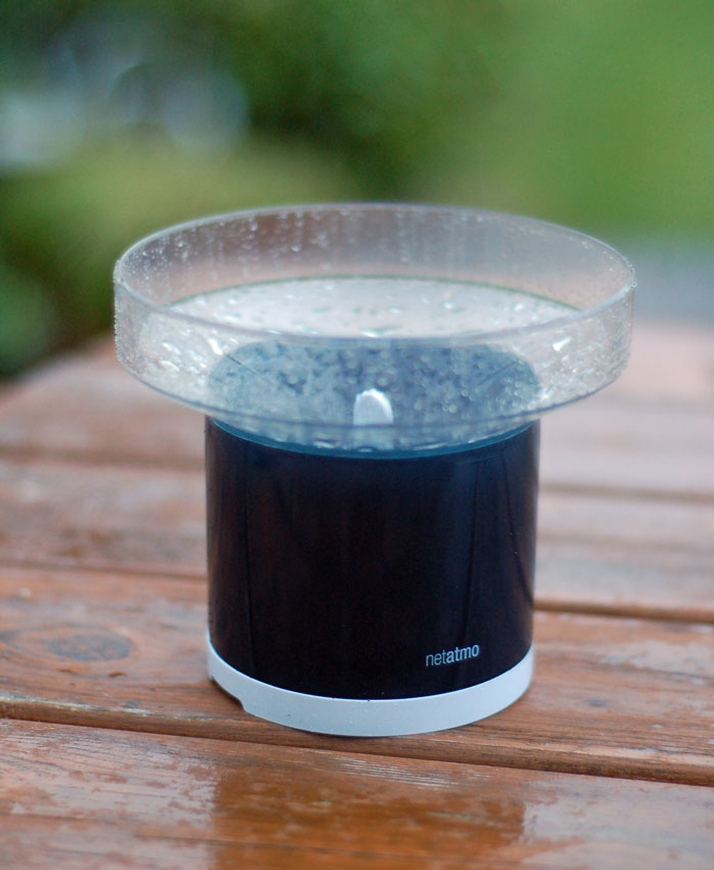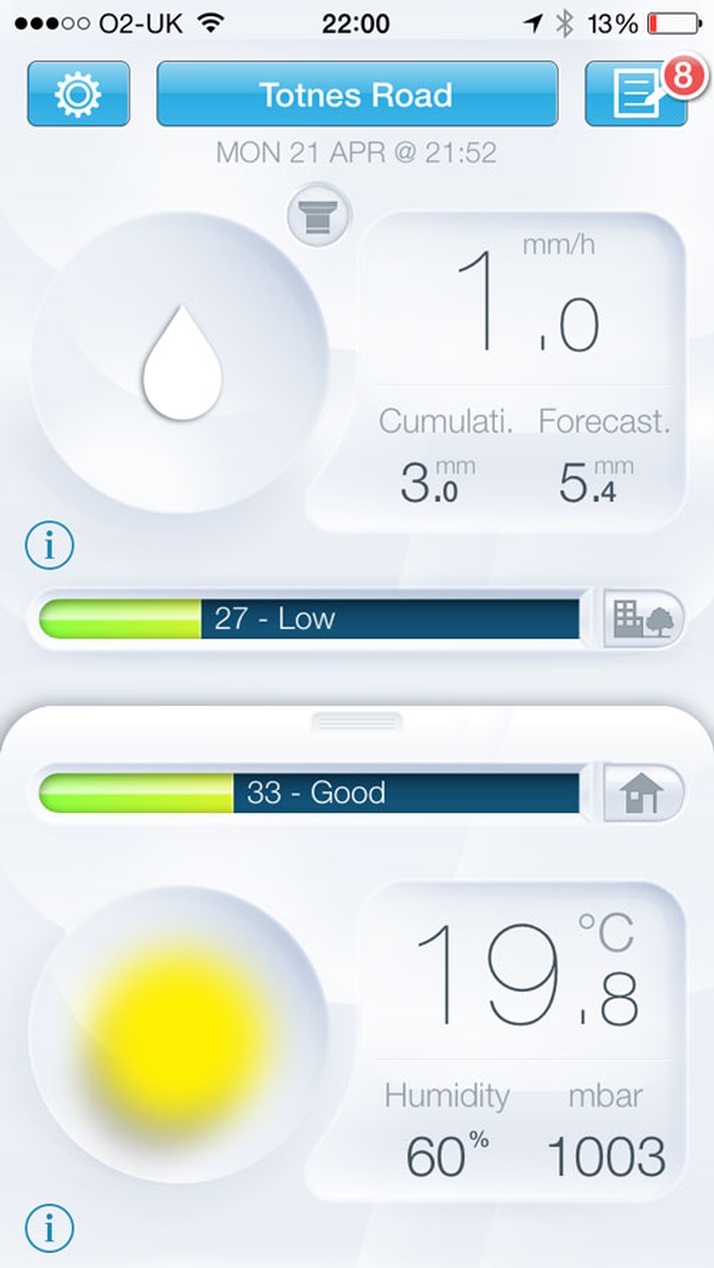The kit consists of two sensors, one which stays indoors and another which resides outdoors. Information is sent via Wi-Fi to your router, and uploaded to Netatmo’s servers. To view the data, including temperature, humidity and pressure, you can install the free app for iOS or Android. As long as you have an internet connection, the app displays the latest data from your station and can give you alerts. Below is our original review, written when the Weather Station launched in 2013.
Buy the Netatmo Weather Station from John Lewis for £119.99
Netatmo Weather Station review: Features and design
Both sensors look sleek in aluminium and white plastic, and the mains-powered indoor unit has a strip which glows various colours depending on its status. The smaller outdoor sensor is powered by four AAA batteries and has a recess on the back for wall mounting (a wall plug and screw are included along with batteries). It isn’t waterproof and the manual suggests you place it under the eaves of your house. Netatmo says the batteries should need replacing only once a year, but as we’ve had only a couple of weeks of testing, we can’t verify that. Being a keen gardener, I put it in the greenhouse at the bottom of the garden, some 40m away from the main sensor. Netatmo claims a range of up to 100m, but that’s with no obstables. I had one or two signal problems during my testing, but there were several walls between the sensors. Moving the indoor sensor so there was only one wall separating the units solved the problem. As the units are pre-paired, that’s one less job to do and makes for very easy installation.
Once you’ve installed the app (there are separate iPad and iPhone versions), you connect your device via its USB cable to the back of the main sensor and the app detects it automatically. You then pick a Wi-Fi network, enter the password and set a name for your station. UPDATE: The latest version of the kit has only a micro-USB connection and setup is automatic via Bluetooth instead of a wired connection. Your Wi-Fi settings are cloned from your iPhone, so there’s no need to enter a password. With that done, can you tap the top of the sensor to take a manual reading and check everything is working. There’s no subscription fee, so while the initial cost is fairly high, there are no subscription costs to pay.
Netatmo Urban Weather Station: apps
I used both the iPhone and iPad apps and both are pretty good. The iPhone’s smaller screen means you don’t see as much information at once, but rotating it switches to graph view and sliding the bottom portion of the main screen downwards reveals more outdoor details (such as 24-hour low and high temperatures) plus a seven-day weather forecast.
Sliding it upwards displays more details about indoor conditions such as CO2 and noise levels. Unfortunately, it doesn’t measure carbon monoxide. Both sensors also measure humidity, but only the indoor module can sense barometric pressure. There are some default alerts, such as when the CO2 level exceeds 1000ppm, but you can set custom alerts for any measurements. For me, that meant I could set alerts to tell me if the greenhouse temperature got too high or too low: information that could save the loss of plants worth considerably more than the price of the kit. You can create as many alerts as you like, and disable any or all of the default notifications. There are plenty of uses for notifications. One of the defaults alerts you if the pressure drops more than 2mbar in an hour (an indicator of poor weather) and another warns if the indoor temperature goes below 10 degrees (alerting of a possible central heating failure). Being able to view a graph of any measurement over time can be helpful in certain situations, but like the ability to record sound levels, may be an unnecessary frill for some. Automatic measurements are taken every five minutes, so there’s plenty of data to pore over, and it’s easy to pinch to zoom in and out of graphs. We’d like to see an option for an absolute scale, though. Graphs automatically adjust the y-axis depending on the data, instead of starting at zero. You can give others access to your Weather Station: all they need is the app, or to log in to the website:
If you buy more than one Weather Station, it’s easy to switch between them within the app. Additional indoor sensors are available to buy at £59 each and can be used to monitor temperature and air quality in more than one room. Up to three can be added. You can’t buy extra outdoor sensors, but the rain gauge is £59 from John Lewis.
Netatmo Urban Weather Station: rain gauge
The latest addition to the Urban Weather Station is a rain gauge. It isn’t quite as stylish as the aluminium sensors in the main kit: it’s made entirely from plastic. It’s powered by a pair of AAA batteries (like the outdoor sensor) and is obviously waterproof. It uses a tipping bucket mechanism to measure rainfall: a magnet passes a solenoid and the number of tips is counted. Netatmo says it’s accurate to within 1mm/hour (measuring as little as 0.2mm/hour). Unless you’re a farmer, you probably won’t be too bothered by accuracy, though, and if you do need accurate measurements, the gauge can be calibrated in the app. For most people, the two main reasons to add a rain gauge to your Urban Weather Station will be to set an alert when it starts raining (so you can nip out and get the washing in) and to figure out when you need to water your garden. You can see the current rainfall in the app (or on the website) as well as cumulative rainfall. Otherwise, apart from the novelty of being able to track when and how much it rained, there’s not much incentive to spend an extra £60 or so on the gauge. We tested the gauge before it went on sale and the app hadn’t been fully updated from French to English, leaving us to add a Nouveau pluviometre. Once paired, you can place the gauge up to 100m away from the base station. We tested at around 25m with several walls in the way and had no signal problems. (Note: The app has been completely overhauled since the review was written.)
Graphs of rainfall over time are available when you select the gauge from the drop-down menu
Netatmo Urban Weather Station: bottom line
We’ve already mentioned that there’s no carbon monoxide sensor, and another gripe is that there’s no display on either sensor, so you can’t see the temperature without firing up the app. Even though you can now pick it up for just under £120 it’s still a lot of money given that a basic weather station with an outdoor sensor and hygrometer can be picked up for around ten times less. The advantage with the Netatmo, of course, is remote monitoring and alerts. If you need these features, and want to be able to track measurements over time, the price may not be such a barrier. Jim has been testing and reviewing products for over 20 years. His main beats include VPN services and antivirus. He also covers smart home tech, mesh Wi-Fi and electric bikes.







